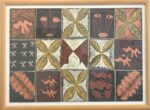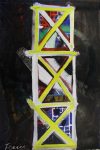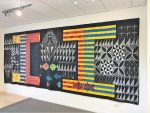Fatu Feu’u
For background on the artist and works, see below.
Current Works
About the Artist
Fatu Feu’u – Background
In speaking about his art practice, Feu’u asserts an intention to mediate an understanding of Samoan culture and history. What is equally apparent is that Samoan culture is the filter through which Feu’u interprets all that is around him. From national issues of race relations in New Zealand, and international conservation concerns, to very personal themes of a child’s struggles and personal estrangements, all are worked through a very Samoan world view.
– Art New Zealand, 2004
Fatu Feu’u explores motifs of Pacific and particularly his Samoan culture but with a strong modernist interpretation, in paintings, limited editions and dramatic sculptures. His love of Picasso and the early 20th century modernists is also evident, but he has established a distinctive style which sees him recognised as one of the leading New Zealand Pacific artists.
Fatu Feu’u was born in Samoa in 1946 and moved to New Zealand at the age of 20, working in textile design before becoming a full-time artist in his early 40s – encouraged by his friends and mentors Pat Hanly, Tony Fomison and Philip Clairmont, all major artists of the 20th Century. He now works between New Zealand and Samoa, and is known for work that blends traditional imagery with Western influences.
He has won major art awards including the James Wallace (1995) and the Pacific Islands Artists Award (1996). His work is held in major collections including New Caledonia, Australia, New York and Germany, and he has undertaken significant commissions for works throughout the Pacific. He was awarded the Order of New Zealand Merit in 2001 for services to the arts.
His work draws inspiration from ancient designs and patterns – from tapa cloth, lapita pottery, and tattoo – which were informed by cultural values of balance, symmetry, and reciprocity. However, he adds his own personal meanings and metaphors.
Over the past decade, Fatu Feu’u has developed a series of works based on the Samoan tradition of ‘ifoga’ or reconciliation/rebuilding after a terrible event or action. The central letter ‘I’ as a motif captures this, with different colours coming together, meeting half way. This can be a meeting between families, tribes, villages or even nations, often to reconcile after someone has wronged another person or party.
His most recent work incorporates his traditional motifs with freewheeling abstraction, mostly related to issues of climate change and the impact on the reefs of the Pacific Islands.
Recent Works
A new series of significant paintings meld traditional Feu’u motifs such as atua, long-nosed god, and symbols of voyaging, with his recent expressive abstract technique, creating an overlay relating to issues of conservation and sustainability and impact of climate change on the Pacific.
The Tapui works, unique handpainted woodcuts on heavy paper, carry a powerful central motif of tapu areas ‘protected’ by squares with a cross through them, with suggestions of sails and traditional motifs in the background. The sails are sometimes faintly defined, implying spiritual guardians of the ocean resources. Tapui effectively means a protection over a place or object of major significance.
We also have in stock selected earlier limited edition prints by Fatu Feu’u, some the last of edition. Maui Tikitiki and Hinemoa Springs are from a series of handworked woodcuts focused on water and its legends. The colours red and yellow are signifiers of the place of the high chief and the orator respectively, and appear frequently in his paintings and sculptures.
More About the Artist
Feu’u was offered the MacMillan Brown residency at the University of Canterbury in 2011, the only artist ever to have the residency twice. He was asked in particular to encourage young contemporary artists of Pacific heritage to express their identity, spirituality and culture – this later resulted in a duo show with then Masters of Fine Arts student Josh Bashford at The Diversion Gallery.
Please contact us to confirm current prices: most prices are posted at the time of exhibition, and may be revised as the artists' values increase.

















